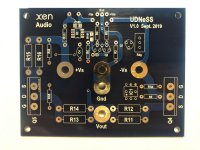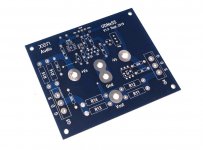Simulation is a very useful design tool to allow you to vary parameters.
Mordern-day engineering can hardly do without simulations, whether in Space or in F1.
Of course you always need to check against reality.
Simulation is only as good as the model you use.
And THD also does not tell you the entire story about how it sounds.
And how it sounds vary from one person to anther.
Cheers,
Patrick
Mordern-day engineering can hardly do without simulations, whether in Space or in F1.
Of course you always need to check against reality.
Simulation is only as good as the model you use.
And THD also does not tell you the entire story about how it sounds.
And how it sounds vary from one person to anther.
Cheers,
Patrick
Of course you always need to check against reality.
Simulation is only as good as the model you use.
And THD also does not tell you the entire story about how it sounds.
And how it sounds vary from one person to anther.
Ah, well, my question was not about "how does it sound", that would be asking way too much! I was more interested about the fact that the original idea for the J2 was to use the SemiSouth parts instead of the IRFPs, because the SemiSouths allow lower distortion. This is in contrast to your simulation, which seems to indicate that the IRFP version has similar (if not lower) distortion as the SemiSouth version.
If you read the article carefully, you will know how the lower transconductance of the IRFP is being compensated by the increase in input stage gain.
All information have been published and explained.
I can also show a simulation where the distortion is 10x lower by increasing the OLG further by a current mirror.
In a very similar way that opamps has ultra low distortion of < -120dB.
But that is not the purpose of this exercise.
Cheers,
Patrick
All information have been published and explained.
I can also show a simulation where the distortion is 10x lower by increasing the OLG further by a current mirror.
In a very similar way that opamps has ultra low distortion of < -120dB.
But that is not the purpose of this exercise.
Cheers,
Patrick
I was asked if an NMOS version would work.
I was not going to publish this, but yes it will work.
You will need unobtanium 2SJ74or 2SJ109, but you can still get those in GR grade (min 4mA Idss).
Since it is the UDNeSS with reversed polarity, it will have to be called RUDNeSS.

Patrick
.
I was not going to publish this, but yes it will work.
You will need unobtanium 2SJ74or 2SJ109, but you can still get those in GR grade (min 4mA Idss).
Since it is the UDNeSS with reversed polarity, it will have to be called RUDNeSS.
Patrick
.
Attachments
And currently the store has LSJ74 matched pair in stock. Let's support the forum.You will need unobtanium 2SJ74or 2SJ109, ...
As we are not using Power JFETs anymore, we can also use MOSFETs for the front end, as in the Pass Aleph.
So instead of unobtanium 2SJ74, how about not-so-unobtanium 2SJ79 ?
2SJ79 Japan-Transistor pnp 200V 500mA 30W TO220AB von Renesas (Hitachi) | eBay
UDNeSS with J113 is still unbeatable for value.
Patrick
.
So instead of unobtanium 2SJ74, how about not-so-unobtanium 2SJ79 ?
2SJ79 Japan-Transistor pnp 200V 500mA 30W TO220AB von Renesas (Hitachi) | eBay
UDNeSS with J113 is still unbeatable for value.
Patrick
.
Attachments
My LTSpice tells me I don't have a model for the J113. How should I proceed?A spice file to play with.
Patrick
.
Mine has. 
So you can do a couple of things :
1) Update your LTSpice.
2) Put one of the models from the net into the .asc file, like the IRFP240.
Philips Semiconductors - Discretes - Concise Catalog 2000
Standard.jft - LTwiki-Wiki for LTspice
Patrick
So you can do a couple of things :
1) Update your LTSpice.
2) Put one of the models from the net into the .asc file, like the IRFP240.
Philips Semiconductors - Discretes - Concise Catalog 2000
Standard.jft - LTwiki-Wiki for LTspice
Patrick
People rather copy those of Nelson, to the last µm. 
GB "long and skinny" FirstWatt J2 clone PCBs
Patrick
GB "long and skinny" FirstWatt J2 clone PCBs
Patrick
- Home
- Amplifiers
- Solid State
- UDNeSS, or You don't need Semisouth's

